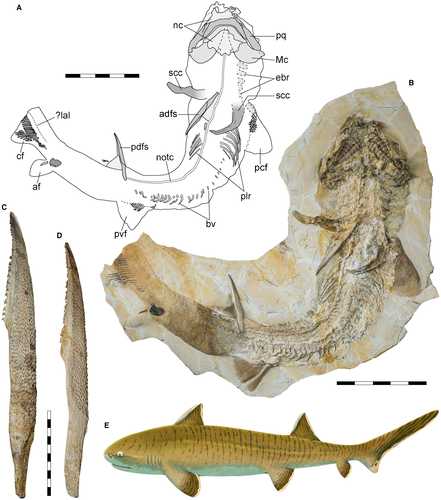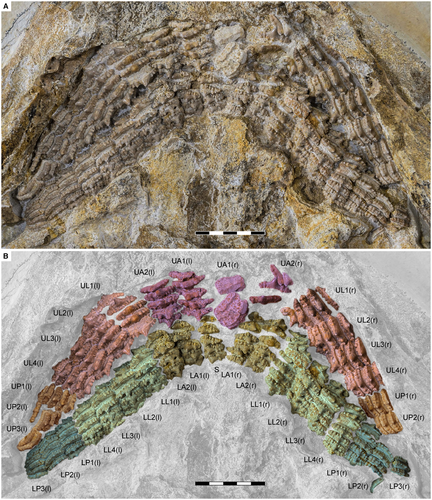@WFS,World Fossil Society,Riffin T Sajeev,Russel T Sajeev
In a new study, an international research team led by Sebastian Stumpf from the University of Vienna describes an exceptionally well-preserved skeleton of the ancient shark Asteracanthus. This extremely rare fossil find comes from the famous Solnhofen limestones in Bavaria, which was formed in a tropical-subtropical lagoon landscape during the Late Jurassic, about 150 million years ago. The almost complete skeleton shows that Asteracanthus was two-and-a-half meters long in life, which makes this ancient shark one of the largest of its time. The study is published in the journal Papers in Palaeontology.

Asteracanthus ornatissimus Agassiz, 1837, PBP‐SOL‐8003, from the lower Tithonian of Solnhofen, Bavaria, Germany. A, interpretative line drawing. B, slab containing specimen. C, close‐up view of anterior dorsal fin spine. D, close‐up view of posterior dorsal fin spine. E, tentative life reconstruction of female A. ornatissimus (by Fabrizio De Rossi). Abbreviations: adfs, anterior dorsal fin spine; af, anal fin; bv, basiventral; cf, caudal fin; ebr, epibranchial; lal, lateral line; Mc, Meckel’s cartilage; nc, neurocranium; notc, notochord; pcf, pectoral fin; pdfs, posterior dorsal fin spine; plr, pleural rib; pq, palatoquadrate; pvf, pelvic fin; scc, scapulacoracoid. Scale bars represent: 50 cm (A, B); 10 cm (C, D).
Cartilaginous fishes, which include sharks and rays, are one of the most successful vertebrate groups still alive today. Due to their life-long tooth replacement, teeth of cartilaginous fishes are among the most common fossil vertebrate finds. However, the low preservation potential of their cartilaginous skeletons prevents fossilization of completely preserved specimens in most cases. The extremely rare preservation of fossil cartilaginous fish skeletons is therefore linked to special conditions during fossilization and restricted to a few fossil-bearing localities only.

Asteracanthus ornatissimus Agassiz, 1837, PBP‐SOL‐8003, from the lower Tithonian of Solnhofen, Bavaria, Germany. A, photograph of dentition. B, interpretation. Abbreviations: LA, lower anterior teeth; LL, lower lateral teeth; LP, lower posterior teeth; S, lower symphyseal teeth; UA, upper anterior teeth; UL, upper lateral teeth; UP, upper posterior teeth; (l), left; (r), right. Scale bars represent 5 cm.
The Solnhofen limestones in Bavaria, Germany, which were formed during the Late Jurassic, about 150 million years ago, is such a rare occurrence. They are world-renowned for having produced skeletons of the small feathered dinosaur Archaeopteryx and have yielded numerous shark and ray skeletons, recovered during excavations over the past 150 years. A new study published in the journal Papers in Palaeontology and led by the paleontologist Sebastian Stumpf from the University of Vienna presents the largest fossil shark skeleton that has ever been discovered in the Solnhofen limestones. The specimen is represented by an almost completely preserved skeleton of the extinct hybodontiform shark Asteracanthus, the total length of which was two-and-a-half meters in life, which made it a giant among Jurassic sharks.
Hybodontiform sharks, which are the closest relatives of modern sharks and rays, first appeared during the latest Devonian, about 361 million years ago, and went extinct together with dinosaurs at the end of the Cretaceous, about 66 million years ago. They had two dorsal fins, each supported by a prominent fin spine. The body size of hybodontiform sharks ranged from a few centimeters to approximately three meters in maximum length, which consequently makes Asteracanthus one of the largest representatives of both its group and its time. In contrast, modern sharks and rays, which were already diverse during the Jurassic, only reached a body size of up to two meters in maximum length in very rare cases.
Asteracanthus was scientifically described more than 180 years ago by the Swiss-American naturalist Louis Agassiz on the basis of isolated fossil dorsal fin spines. However, articulated skeletal remains have never been found — until now. The dentition of the skeleton is exceptionally well-preserved and contains more than 150 teeth, each with a well-developed central cusp that is accompanied on both sides by several smaller cusplets. “This specialized type of dentition suggests that Asteracanthus was an active predator feeding on a wide range of prey animals. Asteracanthus was certainly not only one of the largest cartilaginous fishes of its time, but also one of the most impressive.” says Sebastian Stumpf.
- Stumpf, S., López-Romero, F.A., Kindlimann, R., Lacombat, F., Pohl, B. & Kriwet, J. A unique hybodontiform skeleton provides novel insights into Mesozoic chondrichthyan life. Papers in Palaeontology, 2021 DOI: 10.1002/spp2.1350



 January 16th, 2021
January 16th, 2021  Riffin
Riffin  Posted in
Posted in  Tags:
Tags: 